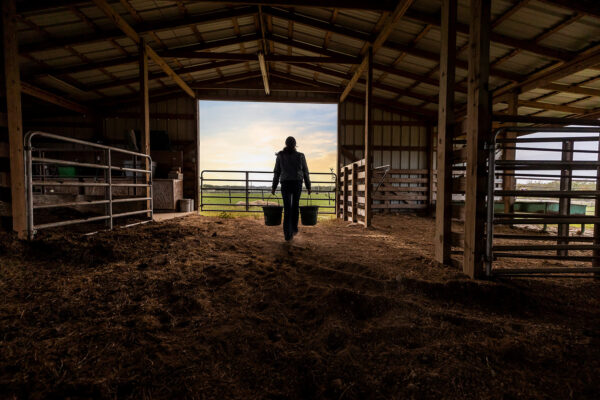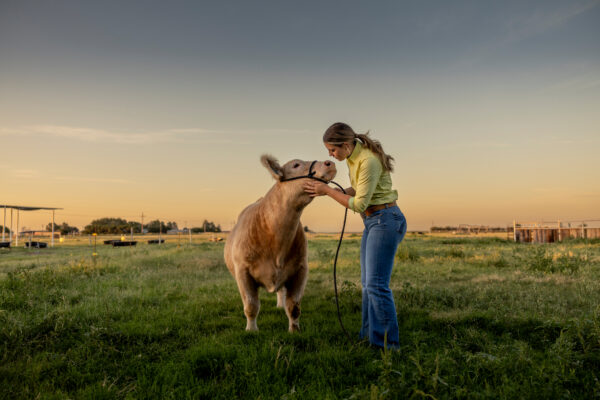Step-by-Step Guide on Getting Your First Farm Loan
Author: Capital Farm Credit
Posted on: 2/5/24
For new farmers and ranchers who need funds, receiving a farm loan will be a crucial lifeline to starting or maintaining operations. Capital Farm Credit knows navigating the loan process can be overwhelming. We’re here to help make sense of the process. In this article, we’d like to share all the necessary steps in the farm loan application process, as well as some tips on making this process easy and comfortable. Without further ado, let’s get started.
Step 1. Preparing for the Farm Loan Application
When preparing to apply for a farm loan, organization is key. Prospective borrowers should gather their financial records, proof of income, social security or ITN numbers, and other documentation in one folder or document box. Necessary documentation often includes financial statements, tax returns, identification, proof of farm ownership or lease, business plans, financial projections, balance sheets, and income statements, if possible.
To improve your chances of loan approval, ensure your business plan is solid and shows the profit potential. Additionally, as soon as you are considering obtaining a farm loan, start clearing any existing debts and improve your credit score by making timely payments.
Step 2. Choosing the Right Agriculture Lender
Selecting a lender is as crucial as choosing the loan itself. Look for a lender like Capital Farm Credit, which has a strong history of serving farmers, ranchers, and the rural agricultural community in Texas. As a lender with a deep understanding of farming, we offer valuable insight and tailored loan products. Trust and reliability are paramount; Capital Farm Credit is a lender known for its excellent customer service and support.
“Our staff is accustomed to the agriculture way of life,” says Josh Krupa, relationship manager. “We have lived the process and understand the unique situations that follow operating as ag producers.”
Different Types of Lender Options for a Farm Loan
First-time farmers have a variety of financial institutions to obtain a farm loan each with their own advantages and disadvantages. Some of the most common lenders include:
- Traditional Banks
- Credit Unions
- Government Agencies
- Private Lenders
- Microfinance Organizations
Choosing the Right Lender
The best lender for your unique circumstances will depend on what you need, financial situation, and long-term goals. When shopping around for a lender, consider these factors:
- Loan amount – How much do you need to borrow?
- Interest rates – Compare rates and fees from different lenders. Credit Unions historically have better rates then big banks.
- Repayment terms – How long do you have to repay the loan?
- Eligibility requirements – Lenders will have different eligibility requirements, make sure you meet theirs.
- Customer service and support – Look for a lender who understands your needs, the farming industry and its unique needs.
It is crucial to develop a solid business plan before approaching lenders. Shop around and compare different offers before signing on the dotted line. Lastly, read all the terms carefully and seek out advice from agricultural advisors.
Step 3. The Farm Loan Application Process
After you have gathered all your documentation and discussed concerns with your lender it is time to start the farm loan application process. The loan application process is straightforward and typically involves several steps.
5 main steps of Farm Loan Application Process:
- Initial Inquiry – Contact the lender to discuss needs and options.
- Application Submission – Providing all necessary documentation and information.
- Assessment – The lender reviews your application against their underwriting criteria.
- Loan Approval and Terms – If approved, you’ll receive an offer outlining the loan terms.
- Acceptance – You accept the terms and finalize the loan.
What could be easier, right? The farm loan application process seems easy on the surface, but challenges are present at every stage. The key is to be prepared and have patience. Even for experienced farmers, farm loans can be confusing, with financial complexity built in at each stage. It’s vital to be prepared for challenges, such as additional documentation requests or the need for collateral. Additionally, there is always a lot of paperwork involved and a certain level of bureaucracy to go through if using government programs or assistance.
Navigating tricky loan structures can be difficult for a first-time farmer or anyone unfamiliar with financial processes. Capital Farm Credit, as your lender, will walk you through each and every stage. We are here to help you navigate this process towards a successful outcome.
Step 4. Farm Loan Approval and Disbursement
Now, you’ve applied for your farm loan and are thankful that part of the process is over. The loan application will go through an assessment and underwriting by the lender. Underwriting is verifying your income, assets, and other details to make sure everything is as it was stated on the application. Underwriting determines how much risk the lender will take if they decide to accept your loan application. It is crucial to have your application complete and accurately filled out.
Often, you may be denied at the underwriting stage if you have not supplied your income or employment history correctly. There are other factors to consider that your experienced relationship manager can discuss in detail the ways in which to get your application stamped with “approved” rather than “rejected.”
Once a loan is approved, the lender will outline the terms and conditions, including the interest rate, repayment schedule, and any covenants or requirements. Understanding these terms is crucial before accepting the loan. Do not hesitate to ask questions at this stage. Disbursement typically follows the signing of loan documents, and the funds are transferred directly to you or the vendor (in the case of equipment or land purchases).
Step 5. Repayment and Managing the Loan
As stated above, knowing all the terms and conditions is vitally important. Effective farm loan management involves understanding your repayment schedule, staying ahead of payments, and being aware of any prepayment options or penalties. It’s important to communicate with your lender if facing financial difficulties. Proactive loan management helps avoid common pitfalls like missed payments or defaults.
Successful loan management is crucial for financial well-being and even more so for farmers who rely on loans for operational needs. Here are some strategies to navigate loan repayment like a pro and avoid common pitfalls:
Six Strategies for Successful Farm Loan Management:
- Stay organized
Develop a budget and track your income and expenses meticulously. This will help you allocate funds for loan repayments and other necessities efficiently. - Automate payments
Set up automatic payments to ensure you never miss a due date and avoid late fees, which can add up quickly and will damage your credit score. - Make extra payments
We know this one can be tough, but if your budget allows, consider making extra payments towards the principal. This may significantly reduce the interest paid and shorten the term. - Refinance only when advantageous
Consider refinancing your loan only if you can secure a lower rate. Monitor interest rates frequently. - Communicate with your lender
Communication with your lender is important. If you anticipate any difficulty making a payment, reach out proactively to discuss options and avoid potential defaults. - Protect your credit
To have better access to loan terms in the future, always keep an eye on your credit score. Keep debt under control and set up those automatic payments. A good score will improve your access to better loan terms in the future.
Common Pitfalls to Avoid After You Receive Your Loan
There are a few financial traps you should be aware of after you receive your first farm loan. Avoid these, and your financial future will be stronger.
- Only borrow what you truly need and can afford to repay comfortably. Avoid impulse borrowing or taking on excessive debt that could strain your finances.
- Carefully review the loan terms and fees associated with the loan. Hidden fees or prepayment penalties can catch you off guard and drain your resources.
- Prioritize loan repayments and avoid missing due dates. Even one missed payment can damage your credit score and add substantial late fees.
- Don’t hesitate to seek help if you face financial troubles. Contact your lender or a financial advisor to discuss options and find solutions to overcome challenges.
Additional Tips for Loan Management
Remember, successful loan management and overall financial security take discipline, planning, and constant monitoring of your finances. By adopting strategies and avoiding financial hazards, you can navigate your first-time farm loan confidently. There are other ways in which a farmer or rancher can add and protect their bottom line.
Diversify income sources – Farming as a business is challenged by its many fluctuations. Create a financial buffer by adding different income streams beyond your main agricultural production to better protect yourself from those ups and downs.
Develop contingency plans – Create a contingency plan, maybe even two. Farmers must prepare for unknown circumstances as best they can. Build up emergency funds and have insurance to cover potential losses.
Network with other farmers – You’ll gain invaluable insights from other farmers and ranchers in your area. You’ll learn from each other and avoid costly mistakes.
Capital Farm Credit – Your Agricultural Financing Partner
Farm loans are a valuable tool for farmers at all stages of their careers. By understanding the types of loans available, the application process, and common pitfalls, you’ll be better able to navigate this often-complicated process.
We encourage you to take the next step in your agricultural journey with Capital Farm Credit, your partner in growth and success. Contact us today. Find an office that’s convenient to you, inquire online about our agricultural financing, or speak with one of our expert lending team members at 1-877-944-5500



